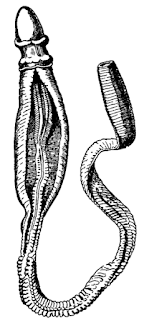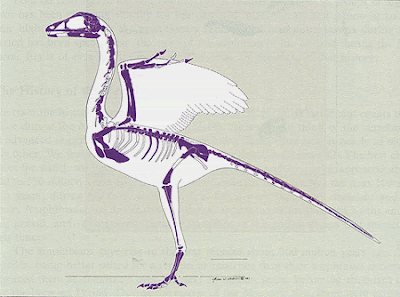 |
| A typical lancelet Branchiostoma. Drawing by Giovanni Maki. |
Brief Introduction
The lancelets (also referred to as "amphioxus" or "amphioxi") are small, translucent and elongated fishlike chordates that are entirely marine and live in shallow sandy environments. They are often used in classrooms as "living fossils" to describe the ancestral chordates. I do find "fishlike" to be too broad of a term to describe these marine invertebrates. I would say they look (though vaguely) resemble lamprey larva or fry in overall shape. And despite what professors in college talk about, are lancelets really good model organisms?
Systematics and Evolutionary History
Cephalochordata has the smallest number species of the three subphyla with at least 34 species. They are classified in the Order Amphioxiformes which is also the only extant clade in Class Leptocardii. Within Amphioxiformes we have two families and a total of three extant genera:
- Branchiostomidae which only contains the genus Branchiostoma
- Asymmetronidae which includes the genera Epigonichthys and Asymmetron
 |
| Pikaia fossil. Photo by Jstuby. |
As mention earlier the overall appearance of these chordates is somewhat not unlike that of lamprey larva. However lancelets lack a cranium case around the head region, thus they lack a distinctive head shape. The brain is very simple and lacks most of the sensory organs, although they have a photoreceptive frontal organ which is ancestral to the vertebrate eye. The pharynx and the gill slits act as filter-feeding apparatus, which the movement of water containing food particles goes through via cilia action. The cilia are dozens of tentacle-like structures near the opening or the ridges of the mouth known as the "wheel of organ". Another series of tentacle-like organs are the oral cirri which also partakes in the action.
Being a invertebrate it has no true backbone. To protect the notochord lancelets have stiffen cells that surround the region. The notochord extends from the tip of the snout to the end of the tail. In addition to giving the animal support and structure, it also helps lancelets to burrow themselves in the sand in coastal waters. To move around lancelets swim in side-to-side action with the help of the myomeres. The tail is fishlike in appearance and can swim surprisingly well. They do not have an recognizable fins except for a dorsal fin.
But what is peculiar about the overall anatomy of lancelets is that most of the organ systems are alternated on either sides of the animal as opposed to being set in a series of successions on either side seen in vertebrates. Not surprisingly, their organ systems in particular their circulatory system and digestive system is simple in comparison to our own For example the lancelets do not have a recognizable true heart nor neural control for pumping blood; the circulatory system is more large and open and no red blood cells. There is no muscular stomach, liver and pancreas (though midgut cecum might be homologous to the last two organs; Pough et. al, 2005).
Lancelets have multiple gonads that produce large quantities of sperm and eggs (noticed the circular organs in the image above in this post.), which leads us to our final segment for the lancelets.
Life History
All species of lancelets have more or less the same life story. All species reproduce sexually and spawn sperm and eggs which simultaneously fertilized in the water. Once the young hatch they buried themselves in the sand where they mature. Most of their adult too is buried in the sand, with their heads sticking out as they are filtering out the food from the environment. However lancelets are forever capable of free-swimming animals and they hardly changed their physical appearance. It would probably surprise some people to know that lancelets are considered to be a food source in Asian countries, often used as animal feed for domesticated animals.
What's Next?
The next group will be the tunicates. As they are the most diverse and numerous of the groups that will be cover in this series, there might be a two-part articles concerning them. In the first post of the two articles will be in similar fashion to this article, but in the second post will briefly go over the life histories of the three classes of the tunicates.
References
 |
| A - Lamprey larva; B - Lancelet adult. |
Being a invertebrate it has no true backbone. To protect the notochord lancelets have stiffen cells that surround the region. The notochord extends from the tip of the snout to the end of the tail. In addition to giving the animal support and structure, it also helps lancelets to burrow themselves in the sand in coastal waters. To move around lancelets swim in side-to-side action with the help of the myomeres. The tail is fishlike in appearance and can swim surprisingly well. They do not have an recognizable fins except for a dorsal fin.
But what is peculiar about the overall anatomy of lancelets is that most of the organ systems are alternated on either sides of the animal as opposed to being set in a series of successions on either side seen in vertebrates. Not surprisingly, their organ systems in particular their circulatory system and digestive system is simple in comparison to our own For example the lancelets do not have a recognizable true heart nor neural control for pumping blood; the circulatory system is more large and open and no red blood cells. There is no muscular stomach, liver and pancreas (though midgut cecum might be homologous to the last two organs; Pough et. al, 2005).
Lancelets have multiple gonads that produce large quantities of sperm and eggs (noticed the circular organs in the image above in this post.), which leads us to our final segment for the lancelets.
Life History
 |
| Typical feeding fashion. Photo by Colin Gray. |
What's Next?
The next group will be the tunicates. As they are the most diverse and numerous of the groups that will be cover in this series, there might be a two-part articles concerning them. In the first post of the two articles will be in similar fashion to this article, but in the second post will briefly go over the life histories of the three classes of the tunicates.
References
- Hildebrand, M. & Goslow, G. (2001). Analysis of Vertebrate Structure. John Wiley & Sons, 24-25.
- Lacalli, T. (2012). The Middle Cambrian fossil Pikaia and the evolution of chordate swimming. EvoDevo, 3(1), 1-6.
- Li, G., Yang, X., Shu, Z., Chen, X., & Wang, Y. (2012). Consecutive spawnings of Chinese amphioxus, Branchiostoma belcheri, in captivity. PloS one, 7(12), e50838.
- Morris, S. C., & Caron, J. B. (2012). Pikaia gracilens Walcott, a stem‐group chordate from the Middle Cambrian of British Columbia. Biological Reviews, 87(2), 480-512.
- Pough, F. H., Janis, C. M., & Heiser, J. B. (2005). Vertebrate Life. Pearson/Prentice Hall, 23; 27.























